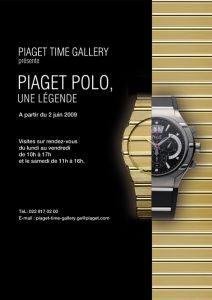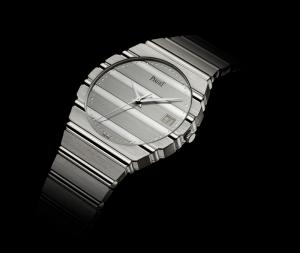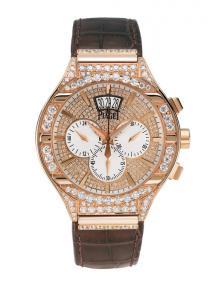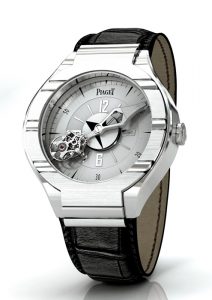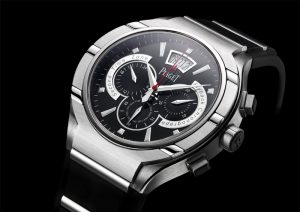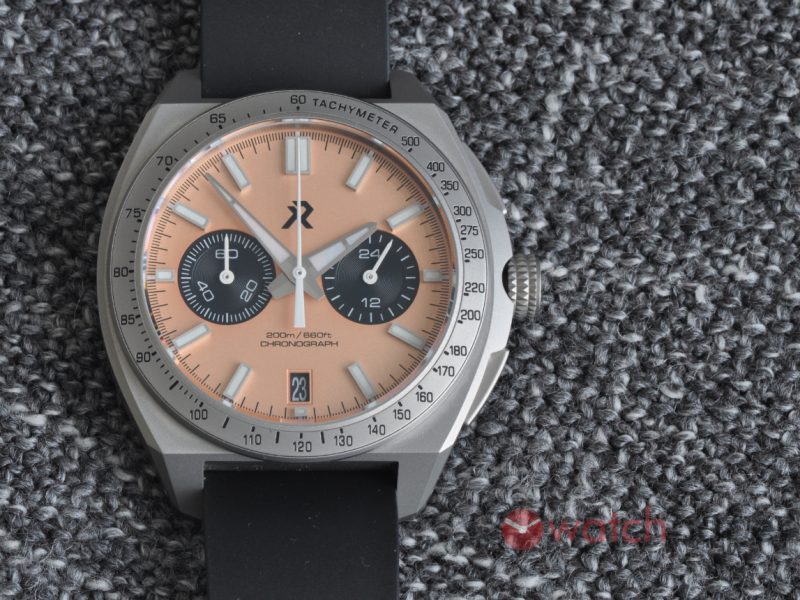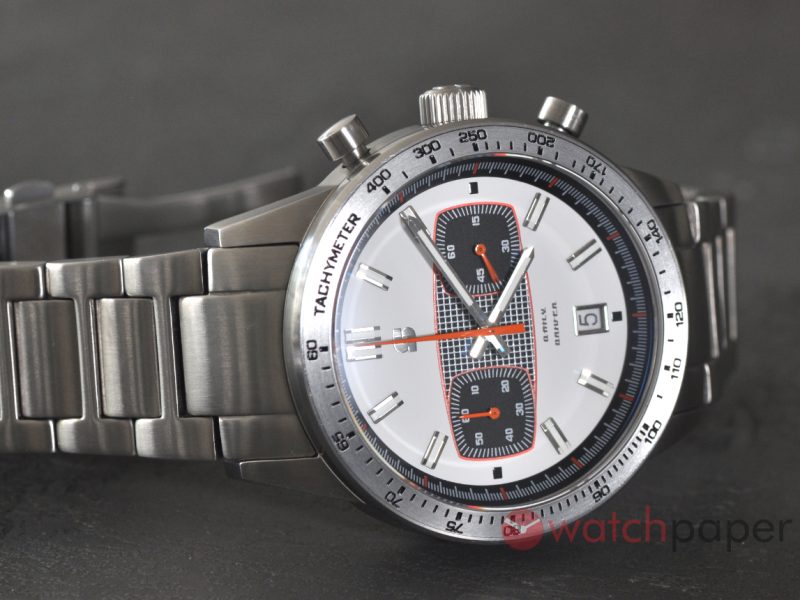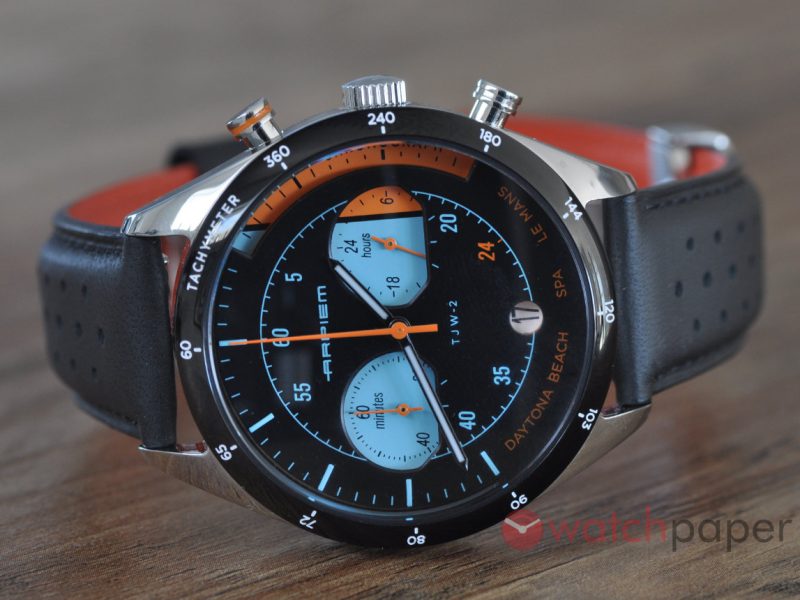PIAGET Polo, a legend
As of June 2nd 209, the Piaget Time Gallery located at 40, rue du Rhône in Geneva, is hosting a new exhibition called PIAGET POLO, A LEGEND.
Piaget is thereby strengthening its ties with the public by offering visitors a chance to discover 30 years of creativity around a legendary watch. This gallery located above its Geneva boutique, historical and contemporary watches along with historical documents retrace 30 years of this emblematic collection.
The exhibition also provides an opportunity to explore the brand’s longstanding passion for polo.
Piaget invites you to experience the saga of this legendary collection, by appointment only,
Monday through Friday from 10 am to 5 pm and Saturday from 11 am to 4 pm.
To schedule a visit, simply contact Piaget on +41 22 817 02 00 or by e-mail at the following address: piaget-time-gallery.ge@piaget.com
1979-2009
And Piaget created the Polo…
For its 30th anniversary, it has treated itself to a makeover in a titanium version. Created by Yves G. Piaget in 1979, the Piaget Polo soon became a star thanks to its design, its elegance and its spokesperson at the time, Ursula Andress. Since then, it has found its way unscathed through changing fashions.
Much more than just a watch or a fashion accessory, it is an authentic symbol of luxury.
Crafted in white or yellow gold, it is worn at any time of the day or night – and that is indeed one of the many reasons behind its amazing success.
“The entire Polo philosophy can be summed up in one sentence: it’s a watch bracelet rather than a mere wristwatch.” Yves G. Piaget
“The Piaget Polo is kind of like my child”, explains Yves G. Piaget, “and I’m always a little moved when talking about it.” Both moved and proud, since not many people have been fortunate enough to father a star that has been shining in the fine watchmaking universe for the past 30 years. Numerous press clippings and pictures from that period testify to its amazing popularity, including snapshots of Pop Art king Andy Warhol, stunning actress Brooke Shields, jazzman Sammy Davis Junior, along with two stars from the famous American Dynasty soap opera, John Forsythe and Pamela Sue Martin… All of them have at one time worn the legendary gold bracelet.
“It represented the first time one of our watches was created to meet demand and not ‘imposed’ on the market as the custom used to be”, recalls Yves G. Piaget. “In 1979, it matched a strong desire expressed by the American market: our retailers wanted a luxury sports watch. In technological terms, we had just introduced the Piaget 7P quartz-powered analog-display movement driving classic hands on a conventional dial display. At just 3.1 mm thick, it was the thinnest in the world, and also a rare commodity due to being produced in extremely limited numbers. Around that same period, our designers had the idea of creating dials that were totally integrated within a solid gold bracelet alternating satin-brushed gold for the flat links and polished links on the gadroons. Since then, the DNA of this watch has remained unchanged, even though it has adjusted to each new era. A Piaget Polo is always instantly recognisable.”
“Each time people saw the name Piaget, they thought of the Polo, and each mention of the word Polo evoked Piaget…”
Yves G. Piaget
In La Côte-aux-Fées, a small village in the Swiss Jura where the Piaget family had been making its movements for over a century, the launch of this new model was a revolution that raised a burning issue: should it be duly christened? The very idea ran contrary not only to brand tradition, but also to the legendary discretion of the Piaget family. Created in 1874 by Georges-Edouard Piaget, the Manufacture had indeed waited until 1943 before even marketing movements under its own company name. Valentin, the technical director and the younger of the two brothers heading the firm in 1979, was opposed to this innovation.
His brother Gérald was open to persuasion, providing the name appealed to him.
“Since my childhood days, I have always been fascinated by horses”, says Yves G. Piaget. On the family farm in La Côte-aux-Fées, all we had was a draught horse, but it was already my favourite animal. We soon began gravitating around the world of polo, the sport of kings, a luxury hobby and a highly precise discipline. Its name carried prestigious connotations, since it involved an elite. We were exactly on target, in a world combining luxury and sport. What’s more, polo also matched our identity in technical terms. It’s a high-precision sport that calls for anticipating the next move, mastering time and displaying consistent elegance whether on the field or in the grandstands. This highly sophisticated world was definitely that of our clientele.”
First invented in Persepolis at the court of Darius the First, circa 500 BC, polo is the world’s most prestigious sport. All the Persian sovereigns, and possibly even Alexander the Great, along with Attila the Hun, Genghis Khan and Tamerlan, are believed to have practised it. In the 14th century AD, the greatest of the Mughal emperors, Akbar, introduced it in India, where it became the favourite sport of the maharajahs. It was there that the English discovered it in the 19th century, and polo is now an integral part of the traditions of the British royal family. Prince Philip, husband of Queen Elizabeth II, was an avid player, and has been followed by his son the Prince of Wales, and now by his grandsons Prince William and Prince Harry.
“The identity of this watch became so powerful that we received requests for Polos from people who didn’t even know it was a Piaget watch…”
Yves G. Piaget
After lengthy debate, the new watch was indeed christened, albeit very discreetly and for advertising purposes only, without placing this name on the watches themselves. Keenly aware that he had an enormous potential success on his hands, Yves G. Piaget was determined to go an innovative step further by letting the whole world know about it.
Since joining the firm in the early 1960s, Mr. Gérald’s son had become the brand ambassador among celebrities. “My first encounter with the world of show business came in 1964 when I met Maurice Chevalier. I hailed from the tiny village of La Côte-aux-Fées and was rather shy, but nonetheless already fascinated by human relations. Chevalier was a revered figure for the generation represented by my father and my uncle. Things rapidly snowballed from there on. In 1964, I personally introduced Mireille Mathieu when she made her debut on the stage of the Palace Hotel in Gstaad. Later, I took Petula Clark along with me to the royal court of Iran. Around that period, all kinds of rumours were flying around regarding my supposed romantic ties with famous women such as Gina Lollobrigida and even Princess Soraya – whom I had only met twice.”
At the 1980 World Polo Cup in Palm Beach, the Piaget Polo made its grand entrance onto the international jet-set scene. The celebrity press did not yet exist and nobody had yet had the idea of associating stars with the world of luxury. The watch starred in a succession of elegant evenings at Régine’s in New York and gala dinners at the Breakers, the finest hotel in Palm Beach. And to crown it all came an impromptu visit to the stables in the company of one of the world’s most beautiful women, Ursula Andress. The most famous James Bond Girl of all agreed to be the spokesperson for the new watch.
“She was a longtime friend and a great girl”, as Yves G. Piaget reminisces. “She allowed us to take pictures of her with the horses all morning. She also officially presented the Cup, and the pictures were soon circulating around the world.” Each of them featured a gold watch on the star’s wrist that was simply impossible to miss. The Piaget Polo had become an icon.
That same year in 1980, a new quartz movement, Calibre 8P, made its appearance at Piaget and in the Piaget Polo world. “This 1.95 millimetre-thick movement was particularly ingenious”, recalls Yves G. Piaget, and the ensuing success of this model certainly lived up to his expectations and to the passionately dedicated work of the company craftsmen. In the early 1980s, the Piaget Polo accounted for almost one-third of the brand’s watch sales. The enthusiasm of its fans has remained undimmed ever since. Without ever slavishly following fashion whims, the Piaget Polo has nonetheless consistently adjusted to mood of successive eras.
In 2001, it was given a facelift. It adopted a more graphic dial, a generous volume and a special curve that guaranteed a perfect fit and also confirmed the iconic status of the Piaget Polo and its relevance as a large-size model. Friends sitcom star Courtney Cox and her husband David Arquette succumbed to its charms, later followed by other showbusiness stars such as Ben Affleck, Puff Daddy, Rihanna and Alicia Keys.
In 30 years, the Piaget Polo watch has lost nothing of its distinctive character. The same alternating matt and polished surfaces, the same regular radiance of the gadroons, and the same sophisticated integration of the bracelet, case and bezel. In 30 years, it has powerfully demonstrated the strength of its design. It even houses two stellar examples of the art of horology: the tourbillon and the chronograph, both interpreted in an original way in harmony with the spirit of the House.
The tourbillon, the complication most symbolically representative of the watchmaking art, takes on an amazing and magical dimension in the Piaget Polo, particularly in the Tourbillon Relatif which represents a daring challenge to the laws of gravity and to equilibrium. The gem-set versions of this amazing movement brilliantly testify to the brand’s two-fold technical and jewellery expertise.
In the chronograph version, along with the chronograph and flyback functions, Calibre 880P serves to drive the hour, the minute, small seconds at 6 o’clock, the date at 12 o’clock and the time in a second time zone on a 24-hour scale at 9 o’clock. Equipped with twin barrels and a large balance with screws, this 5.6 mm thick mechanical self-winding movement has a 50-hour power reserve when the chronograph mode is activated. Endowed with a vertical coupling clutch, it boasts all the main features of an authentic Haute Horlogerie chronograph.
The Piaget Polo FortyFive chronograph signalled the dawn of a new era of success, expressing the full force of its modernity with a 45 mm case sculpted from titanium and fitted with a rubber strap. Its sporting appearance makes it ideal for activities such as horse-riding or diving to depths of 100 metres. The bracelet can be lengthened or shortened by pressing twice on the sides in order to enhance wearer comfort according to temperature variations. The signature gadroons are in polished steel and alternate with the satin-brushed titanium. The mechanical self-winding movement created in La Côte-aux-Fées is entirely worthy of the Piaget tradition. The only variable feature is the dial, after which the Piaget Polo FortyFive is named, since it is slightly broader than usual and measures 45 millimetres. For Piaget CEO Philippe Léopold-Metzger, “it corresponds to current tastes, and also to the approximately length of a polo match”. Within this noble sport, Piaget has also a recent noteworthy entrance into the most demanding international polo competition of them all, the Triple Crown. The “Pilàra-Piaget” team which plays for Piaget is composed of some of the world’s finest players: Marcos Heguy, Santiago Chavanne and the two brothers Sebastian and Agustin Merlos. The brand has indeed chosen the team captain Marcos Heguy as ambassador of the Piaget polo line.
“The Piaget Polo has made an indelible imprint on the history of fine watchmaking. It is a symbol of daring creativity.”
Philippe Léopold-Metzger
The Piaget Polo and the sport of polo in ten key dates:
-500 BC: the first historical record of the game of polo in Persia, at the court of Darius the First;
-1000 AD: Chinese emperor T’sai Tsu orders the decapitation of all the players in a polo match that saw the death of one of his relatives;
-1500: the largest polo field ever, measuring 460 metres long and 100 wide, is built in Ispahan, Persia;
-1600: the great Mughal emperor Akbar introduces polo in India;
-1850: the English discover polo in India. The game is named after the Tibetan word pulu for the willow root which serves to make the balls
-1859: the world’s first polo club is founded in Calcutta and named the “Calchar Polo Club”;
-1979: Piaget creates the Polo watch;
-1980: the Piaget Polo watch is officially introduced during the Polo World Cup in Palm Beach, in the company of Ursula Andress
– 2001: launch of the new Piaget Polo
– 2007: launch of the Piaget Polo Tourbillon Relatif
– 2007: launch of the Piaget Polo watch equipped with the 880P movement
– 2008: creation of the Pilàra-Piaget polo team
– 2008: Marcos Heguy becomes official ambassador of the Piaget Polo line
– 2009: the Piaget Polo line celebrates its 30th anniversary: launch of anniversary series at the SIHH
– 2009: launch of the Piaget Polo FortyFive


